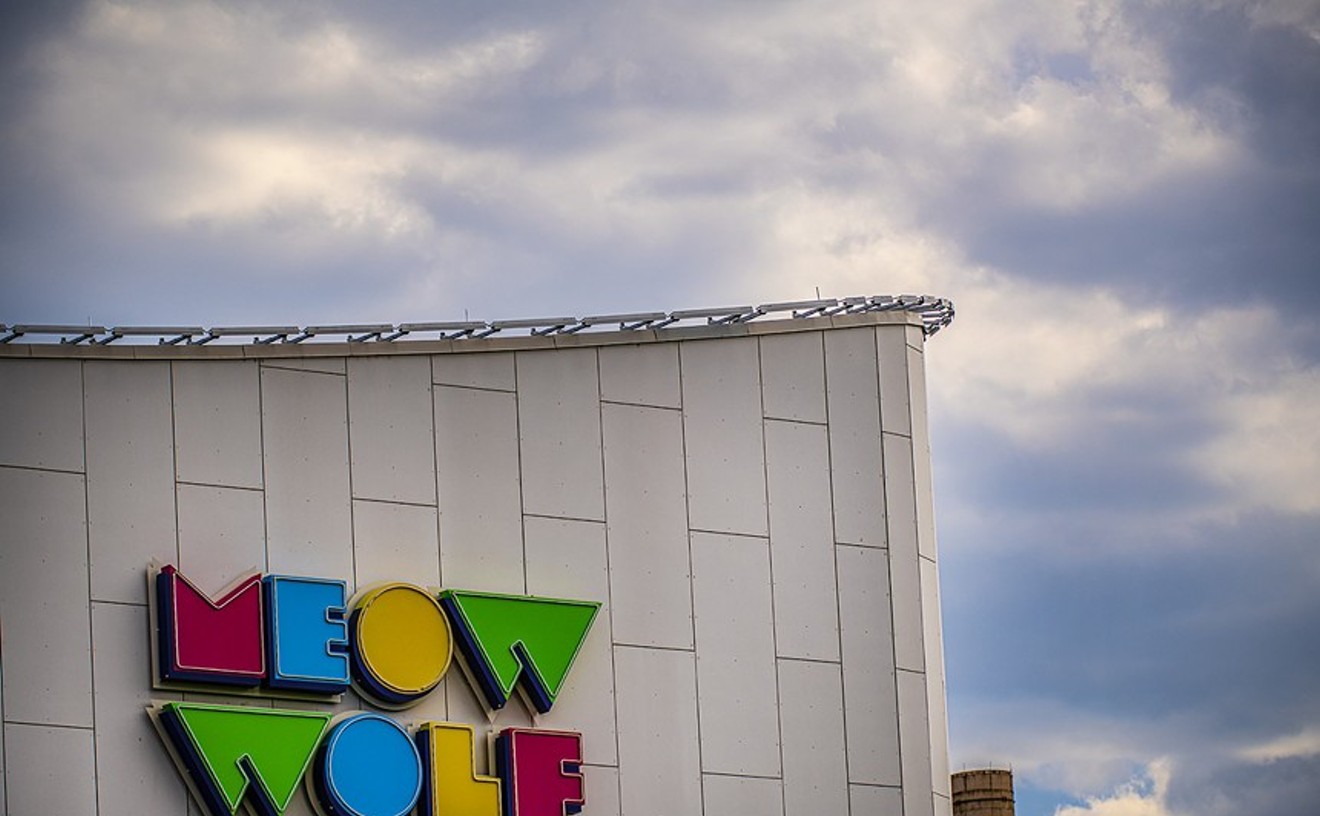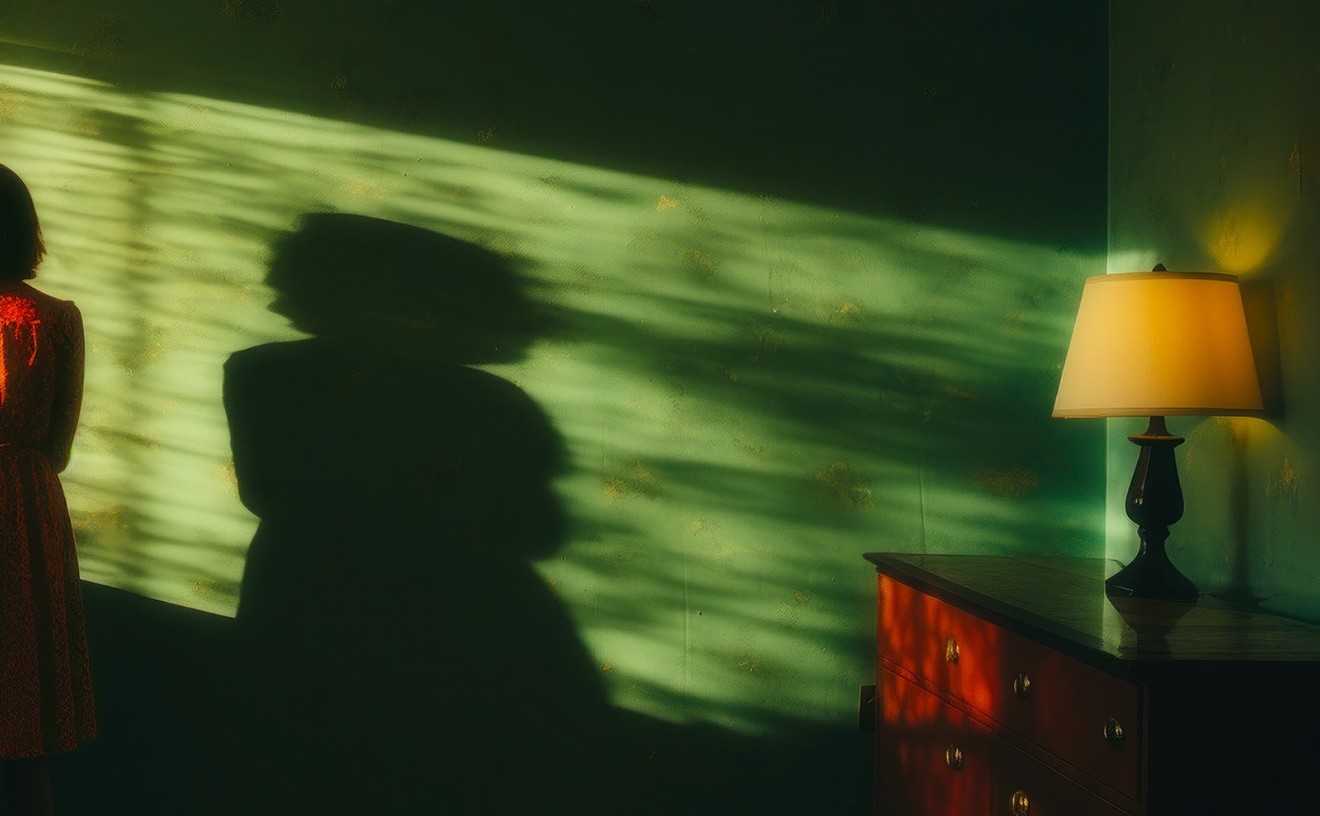This significant sculpture by important artists had to go in order to make room for--no kidding--a sculpture park! Little is known about plans for this park; the designer's name is not even posted at the site. But there is one thing we can be sure of--the sculpture park won't be any good. How could it be, when the first thing on its agenda was the destruction of the Solar Fountain?
Perhaps more understandable than the civic vandalism committed against the Solar Fountain was the more expected, garden-variety vandalism that seriously damaged Roger Kotoske's untitled minimalist sculpture of three red-painted cubes set on end in Burns Park. Nine pieces made up the Denver Sculpture Symposium of 1968; by this year, only four remained in the park. And last month, person or persons unknown set Kotoske's fiberglass-coated plywood sculpture on fire. Word is that the sculpture is to be removed--although, unlike the Solar Fountain, the Kotoske won't require a bulldozer.
Isn't it strange that the possibility of fixing Kotoske's piece hasn't even been discussed, much less seriously considered? Since the sculpture is made of very cheap materials--plywood and paint--how much would it cost to replace the damaged portions and repaint the piece? A few thousand dollars? With all the money the Mayor's Office of Art, Culture and Film has wasted on nonsense, couldn't some be found to repair the Kotoske?
But not all the news on the Denver sculpture front is bad. Recently restored--after having been draped in volleyball netting for five years to protect passersby from falling pieces of the crumbling concrete from which it was made--is the seemingly good-as-new Sullivan Gateway on the Esplanade at City Park, created by New York sculptor Leo Lentelli in 1917. Lentelli's Beaux Arts-style piece is made up of two simple colonnades, each surmounted by a pair of figures. Topping one set of columns are two miners; on the other, two frontier women. Brought back from the brink of destruction, the Sullivan Gateway reclaims its place as one of the city's best examples of public sculpture.
There's also good news for fans of contemporary sculpture--although the glad tidings are only temporary--delivered in the form of Jesus Bautista Moroles, an exhibition of granite sculptures divided between three locales. Small sculptures by Moroles are featured both inside and out at the Artyard Gallery; closely associated mid-sized pieces are on display at the Madden Gallery of the Museum of Outdoor Arts. And last but far from least, large, multi-ton outdoor pieces are installed in MOA's Samson Park.
Taken together, the three parts of this exhibit add up to the most important sculpture show in the region in years--one that's well worth the hours, including travel time, it takes to see everything.
The exhibition was several years in the making. "It was two years ago that I approached Cynthia Madden at the Museum of Outdoor Arts with the idea of presenting a joint exhibit of Jesus's work," says Peggy Mangold, Artyard's well-known director. This is not the first time Artyard and MOA--both of which focus primarily on sculpture--have joined forces; previous outings have included showcases for such noteworthy Denver sculptors as Chuck Parson and Carol Braaksma.
This is the second time Artyard has presented Moroles's sculpture. In 1993 Mangold mounted a much smaller show of the artist's work that, like the current exhibit, was eponymously titled. One reason for cooperating on the much larger Jesus Bautista Moroles is that such a massive exhibition is an expensive proposition; by sharing the show, Artyard and MOA could also share expenses. But another motivation may have been the fact that there is virtually no venue in the region that is large enough to accommodate this major three-part show alone.
Jesus Moroles was born in Corpus Christi in 1950 and studied art at El Centro College in Dallas and at the University of North Texas in Denton. After graduation in 1978, he went to Pietrasanta, Italy, to study the classic techniques of the Italian masters; he remained there through 1980. When he returned to Texas with many lessons learned, he was already well on his way to becoming a major force in contemporary sculpture in the Southwest. Today the sculptor is internationally famous. His stature is so great that in addition to working in his home state, Moroles maintains a studio and gallery in Cerrillos, New Mexico, and he's currently in Barcelona opening yet another studio.
Moroles's Italian training is one of the key elements to the success of his sculpture. It's surely the origin of his classicism, as well as the monumentality of even his smallest pieces--both qualities associated with the Italian tradition. Moroles also often makes reference to the shapes and details associated with ancient Meso-American forms, reflecting his heritage as a Mexican-American. But another attribute, and the one that gives Moroles's work its thoroughly contemporary feel, is the way he combines the classic characteristics of traditional sculpture with the exaggeratedly visible use of power tools, evidenced by the tracks that have been left across the face of the sculptures.
Sometimes Moroles's work recalls Rome, sometimes Mexico City, but it's always about what American sculpture is right now.
The best way to see Jesus Bautista Moroles is to begin at Artyard, proceed to the Madden Gallery at MOA and wind up at Samson Park. This way, the exhibition builds from the private and intimate at Artyard to the public and grand at Samson Park--with the in-between in between at the Madden Gallery.
At Artyard, the small front gallery has been filled with more than a dozen Moroles sculptures. The room is dominated by one of Moroles's signature chessboards, in this case "Granite Chessboard Table," which is made of two contrasting shades of granite: Texas pink and black. A metal-framed table sits on four squat square feet, two in pink, two in black; its surface is in the form of a chessboard, the pink and black used in lieu of the traditional red and black. On top of the table, Moroles has placed six small sculptures like chess pieces.
These small sculptures, along with the chessboard itself, are meant to function singly or in any number of combinations; they also lay out much of Moroles's formal vocabulary. There's a stele, a fish and a stone "weaving," along with other shapes that are less easy to describe. All display Moroles's approach to finish, with shiny, highly polished areas set hard against rough, mechanically cut passages. The small and simple "Concave Stele," for example, could be a scrap of stone. Polished on one side, it looks broken on the other; only Moroles's perfect sense of scale shows the viewer that it was all intentional.
Artyard also includes some exquisite larger steles. "Black Core Totem" is an eight-foot-tall spike of red Fredericksburg granite, both staid and sleek at the same time, like many of the artist's sculptures. Moroles has drilled three large holes through the spike, then filled these with cylindrical plugs of black granite. Using power tools, he has finished one face of "Black Core Totem" with a honeycomb pattern that resembles tire treads; as a result, the piece at once brings to mind both ancient and modern sources.
The exhibit moves into larger pieces at the Madden Gallery. This portion, too, is anchored by a characteristic Moroles chessboard covered with characteristic Moroles sculptures. But here the installation is much larger; instead of taking the form of a table, "Chessfloor"--as indicated by the title--is laid directly on the ground in squares of Texas pink and black granite. Several of the sculptures that top "Chessfloor" illustrate Moroles's consummate skill at carving and cutting stone. In "Interlocking," which is made of Fredericksburg granite, Moroles has dovetailed the stone together vertically, and the fit is perfect. "Granite Weaving," also of Fredericksburg granite, is even more astounding: Moroles has created a vertical grid of interlocking stone that holds together even though he used no mortar or connections of any kind.
For "Moonscape," a highly finished piece of Texas pink and Dakota mahogany granites, Moroles has placed a thin sheet of granite pierced by a series of eye-like holes on top of a cylinder base. The piece, which is too large for "Chessfloor," stands alone at Madden; it's perhaps the finest sculpture in the entire exhibit.
The show's final portion is at the gated Samson Park, on the west side of Fiddler's Green Amphitheater. (MOA owns not only Samson Park but Fiddler's as well, which means it receives rental revenue for events held there.) Just past the gates is the largest Moroles piece, "Granite Hi-Chair." The earthy, pink-colored Oklahoma-granite sculpture, which is over thirteen feet tall, is rough-finished and is reminiscent of the ruins of a Mexican pyramid--a reference enhanced by the crude ladder form up the front. MOA is considering acquiring one of Moroles's works for its extensive permanent collection; this is the one the museum should get.
On display at Samson Park are three of Moroles's large, impressive steles; all feature repeated horizontal elements that suggest a spine. In the black granite "Musical Stele," these repeated horizontals are thin enough to vibrate but thick enough not to break. As the title implies, when the horizontals are struck, the stele emits a sound like that of a harp.
Like "Chessboard Table" and "Chessfloor" at Madden, "Granite Hi-Chair" and "Musical Stele" are nominally functional. But Moroles also creates things that can actually be used. The three "Moonscape Benches," made of Texas granite, all rest on semi-circular bases suggestive of rockers; although it would take a lot of effort to get these to move, sitting on them is easy enough.
And after driving many miles and taking hours to look at these wonderful sculptures, you deserve a rest.
Jesus Bautista Moroles, through August 7 at the Artyard Gallery, 1251 S. Pearl St., 777-3219, and the Museum of Outdoor Arts, 7600 E. Orchard Rd., Greenwood Village, 741-3609; through May 15, 1998, at MoOA's Samson Park, southeast of Fiddler's Green Circle and Greenwood Plaza Blvd., Greenwood Village, 741-3609.










